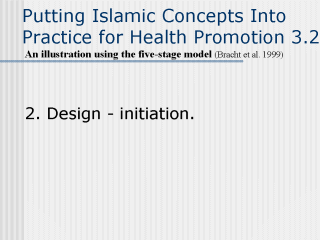| front |1 |2 |3 |4 |5 |6 |7 |8 |9 |10 |11 |12 |13 |14 |15 |16 |17 |18 |19 |20 |21 |22 |23 |24 |25 |26 |review |
 |
The second stage
of Bracht et al. (1999) model is the design and initiation stage, which calls upon the
establishment of a core planning group and selecting a local organizer or coordinator.
Concurrently to this, this stage also calls upon choosing of an organizational structure
and examples of these are given as advisory board, council, coalition, lead agency,
informal network, and grassroots or advocacy movements. In Islam the concept of Shuura is
an example of organizational structure within Islamic community. This concept is
comparable to the description of coalition described by Bracht et al. (1999) as being an
“alliance of several community groups and/ or health organizations”. The
concept of Shuura is not merely an advisory board or a coalition, rather in an Islamic
community Muslims, through Shuura are obliged to work together in mutual consultation and
decisions reached are binding (Hussein, 1998). Therefore this concept offers a possible
entry point into the 2nd stage of Bracht et al. (1999) five-stage model. Reference: Bracht, N., Kingsbury, L. & Rissel L. (1999). A Five stage Community Organization Model for Health Promotion. In Bracht, N (Ed.). Health Promotion at the community Level. (pp 83-104). International Educational and Professional Publisher, Thousand Oaks, California 91320. SAGE Publications Hussein, A. A. (1998). The art of health promotion in Islam and the contemporary public health challenges, MPH Thesis. Maastricht. University of Maastricht. |
| front |1 |2 |3 |4 |5 |6 |7 |8 |9 |10 |11 |12 |13 |14 |15 |16 |17 |18 |19 |20 |21 |22 |23 |24 |25 |26 |review |